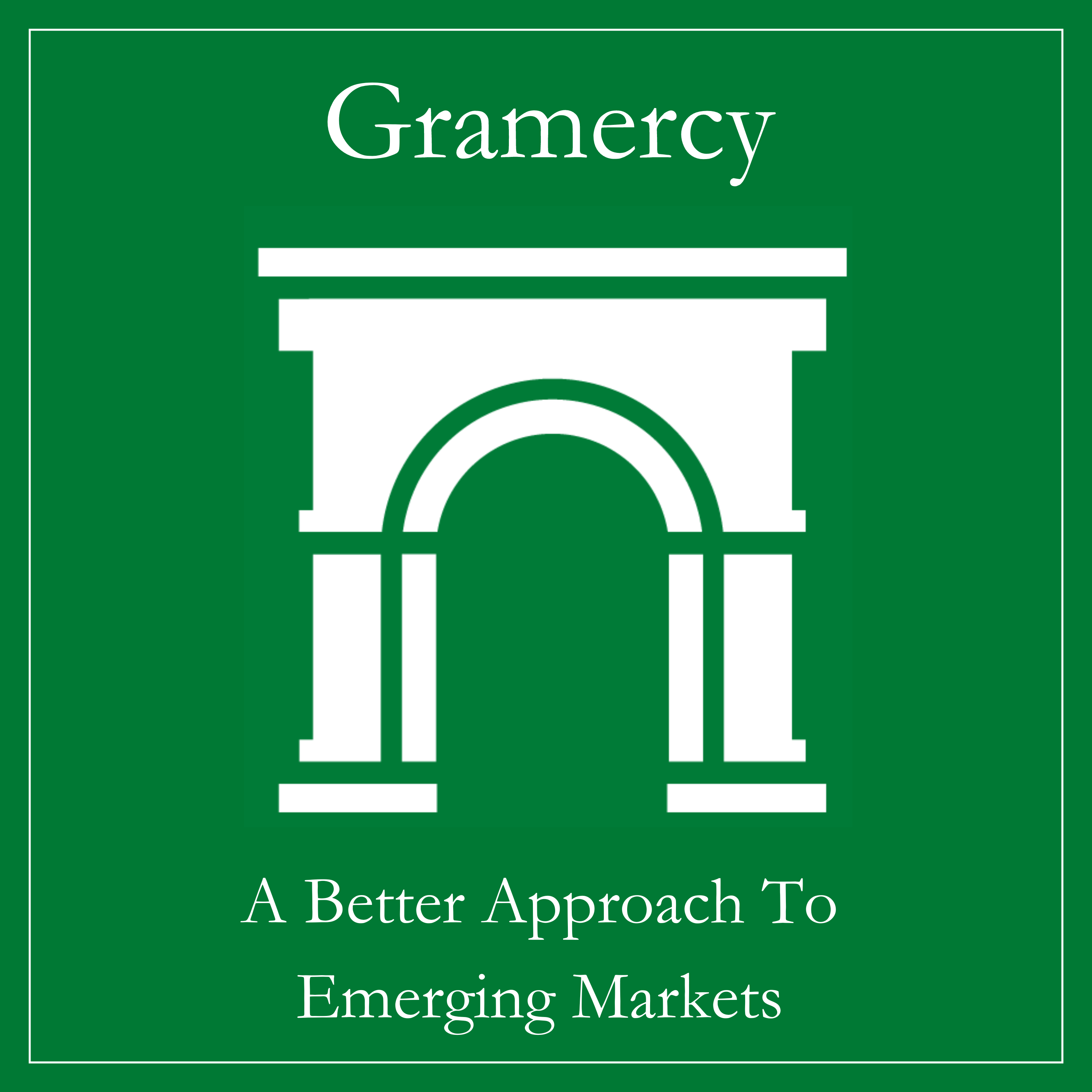Contents
Market Overview
Macro Review
Is the U.S. inflation threat back in vogue? Macro data this week painted a mixed picture about the strength and direction of the U.S. economy and muddied the waters around the Fed’s November decision. September CPI showed mild acceleration in monthly terms, and in annual terms, it was higher than consensus (2.4% YoY vs 2.3%). UST yields initially struggled for direction but ultimately finished the week around the 4.10% level, the highest level since July and some 40bps higher month to date. Fed-speak offered conflicting viewpoints on the FOMC’s trajectory; Atlanta Fed President Bostic made comments that he would be open to skipping a rate cut in November if the data supports it and added that elements in the September CPI release “validate that view”, while his colleague Susan Collins, Boston Fed President, suggested more rate cuts might be needed to “preserve the strength in the economy”. Meanwhile, the Fed minutes from the September meeting were released, revealing that while a substantial majority backed the 50bps cut, some officials preferred 25bps. In China, the National Development and Reform Commission (NDRC) press conference reiterated continued use of special government bond issuance, better use of funding and acceleration of investment project pipelines. Following this, the Ministry of Finance announced a briefing for this Saturday that markets will heed for clues on the scope, timing, and focus of any potential additional fiscal stimulus for the Chinese economy. Geopolitical tensions in the Middle East remained high with Israel intensifying its campaign against Hezbollah in Lebanon and in anticipation of its potential military response against Iran. Diplomatic efforts were ongoing around the clock to reduce the risk of a more significant direct military clash between Israel and Iran, and President Biden spoke on the phone with PM Netanyahu for the first time in months. Crude oil prices trended higher, but Brent finished the week below $80 per barrel. Across EM this week, the Reserve Bank of India (RBI) opened the door to potential rate cuts, Brazil’s Senate confirmed 42-year-old economist Gabriel Galipolo as the Central Bank’s new Governor, Ghana reached staff level agreement on the IMF third review as the restructure sovereign bonds started trading and long-awaited tax reform details were unveiled by the Dominican Republic.
EM Credit Update
Amid the sell-off in DM rates, emerging market sovereign credit (cash bonds) lost 0.6% with spreads 3bps wider at the index level. Sovereign outperformers were Ghana, Gabon and Argentina, while Georgia, Cameroon, and Ecuador underperformed. Corporate credit was 0.3% weaker with spreads 1bps tighter. EM local debt underperformed this week, losing 1.1%.
The Week Ahead
Global markets will digest China’s Ministry of Finance briefing scheduled for today (Saturday); investors are looking for potential policy announcements related to special bond issuance, tax relief measures, and additional spending plans. This briefing should have a significant impact on the near-term trajectory for Chinese markets as investors are still eagerly awaiting fiscal stimulus measures to complement the monetary policy moves in September. Elsewhere in Asia, India’s CPI data for September is due. It is expected to show a rise in YoY inflation due to seasonal factors, but likely temporary and reversed in the coming months. In DM, key data releases next week feature U.S. retail sales as well as inflation in the UK, Japan and Canada. ECB’s policy rate decision on Thursday will be the main monetary policy event.
Highlights from emerging markets discussed below: China talks more about fiscal stimulus, The Reserve Bank of India (RBI) opens the door to potential rate cuts, Brazil’s Senate confirms Gabriel Galipolo as the Central Bank’s new Governor, Ghana reaches staff level agreement on third review as new bonds trade, and Dominican Republic unveils long-awaited tax reform details.
Fixed Income
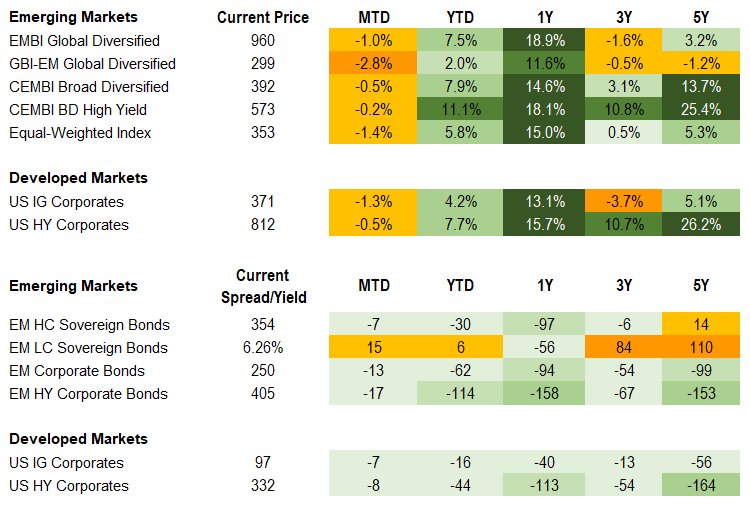
Equities
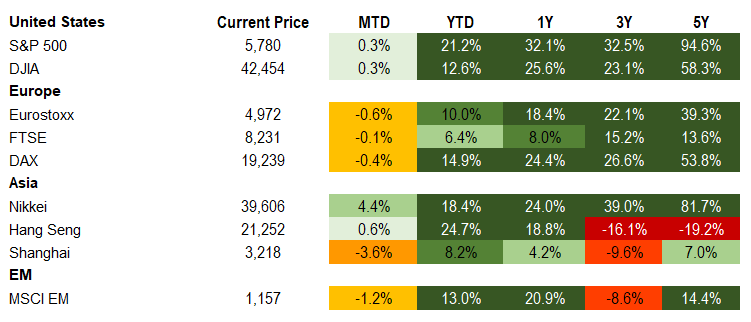
Commodities

Source for data tables: Bloomberg, JPMorgan, Gramercy. EM Fixed Income is represented by the following JPMorgan Indicies: EMBI Global, GBI-EM Global Diversified, CEMBI Broad Diversified and CEMBI Broad High Yield. DM Fixed Income is represented by the JPMorgan JULI Total Return Index and Domestic High Yield Index. Fixed Income, Equity and Commodity data is as of October 11, 2024 (early-morning).
Emerging Markets Weekly Highlights
China talks more about fiscal stimulus
Event: The National Development and Reform Commission (NDRC) press conference reiterated the continued use of special government bond issuance, better use of funding and acceleration of investment project pipelines. Following this, the Ministry of Finance announced a briefing for this Saturday (October 12th).
Gramercy Commentary: The authorities appear more reactive and willing to step-up stimulus in the wake of the Fed’s 50bps cut and recent weak economic data. The amount of fiscal stimulus as well as where the funds are directed will be key in understanding the impact. While it is unclear if such details and forward guidance will be provided by the MOF this weekend, we think there is scope for additional signals on budget augmentation and possible initial guidance on front-loading for 2025. The specific amounts and approval of augmentation is anticipated to be outlined and approved by the NPC and Standing Committee later this month. Beyond this, authorities might be keen to reserve additional ‘stimulus step-ups’ as the global monetary and U.S. political cycles evolve into next year.
The Reserve Bank of India (RBI) opens the door to potential rate cuts
Event: RBI’s monetary policy committee voted (5-1) to hold the main policy rate at 6.5% but changed the Central Bank’s “policy stance” to neutral, signaling it might be considering easing monetary policy in the coming months for the first time since the peak of the COVID pandemic in 2020.
Gramercy Commentary: RBI’s commentary this week suggests that policymakers are growing more comfortable with India’s inflation outlook as food prices, accounting for around 50% of the country’s consumer price basket, are expected to ease in the coming months. However, we think that the RBI is likely to remain highly vigilant to inflation risks and act only on the grounds of incoming data providing solid proof that CPI dynamics are sustainably aligned with RBI’s 4% YoY target. For context, India’s headline inflation on an annual basis fell to 3.6% in July and 3.65% in August, converging to the structural medium-term 4.0% target for the first time since 2019, after its most recent peak of close to 7.5% in July 2023. Against this domestic backdrop and the recent dovish convergence in DM monetary policy, a confirmation of the disinflation trend in the next couple of months should enable the RBI to initiate a rate cutting cycle that would be supportive of India’s already strong GDP growth momentum that stands out among the major global EM economies.
Brazil’s Senate confirms Gabriel Galipolo as the Central Bank’s new Governor
Event: Gabriel Galipolo, a 42-year-old economist nominated by President Lula to take over from Roberto Campos Neto in January 2025 as the Brazilian Central Bank’s (BCB) Governor, easily secured the Senate’s approval in a 66-5 vote on the floor and a unanimous decision in the chamber’s Committee on Economic Affairs.
Gramercy Commentary: Mr. Galipolo has been the head of BCB’s monetary policy department since 2023 and has been rumored since this summer as the favorite to replace Mr. Campos Neto, so investors are very familiar with his profile. The main market concern around Galipolo’s appointment has been the possibility of President Lula applying pressure on his nominee in favor of easier financial conditions, but we believe the new Governor is unlikely to deviate from the BCB’s adherence to objective technical analysis when determining the direction and shape of monetary policy. Moreover, we expect the political noise around the BCB to decrease meaningfully under Galipolo. President Lula will no longer have incentives to criticize the institution’s policy decisions once current Governor Campos Neto leaves since he was perceived to be associated with former president Bolsonaro. Markets will also anticipate who the three new monetary policy committee members will be that President Lula must appoint by year-end. Our expectation is that the Minister of Finance Fernando Haddad and Mr. Galipolo will drive the selection process, ensuring the new directors’ profiles align with the BCB’s policy credibility.
Ghana reaches staff level agreement on third review as new bonds trade
Event: The IMF reached staff level agreement on the third review of Ghana’s Extended Fund Facility, setting the country up to receive $360mm upon board approval. The press release highlighted satisfactory program performance with all June 2024 targets met and ”remarkable progress” made on the debt restructuring. The government announced tenders on its exchange offer of over 98% with roughly 90% of holders opting for the ”Disco” menu of bonds. Bonds began trading in the secondary market this week with yields on the 35s and 37s around 10%.
Gramercy Commentary: The completion of the Eurobond exchange in a relatively swift timeline of less than two years as well as an agreement on the latest IMF review comfortably ahead of the December 7th general election is positive. We do not see significant risks from the upcoming vote with the next IMF review scheduled for May 2025 when targets will encompass the current period running through the election. While some fiscal underperformance is likely with additional pressures from drought conditions, we do not envisage widespread overspending and expect a continuation of solid IMF relations regardless of the election outcome.
Dominican Republic unveils long-awaited tax reform details
Event: The Government presented its tax reform in the Law on Fiscal Modernization this week entailing an estimated 1.5% of GDP in additional revenues stemming from reduced exemptions, refinement of income tax brackets and an increase in property tax among other amendments. The tax adjustments come alongside offsetting spending commitments of 1.3% of GDP.
Gramercy Commentary: Progress towards the passage of the tax reform to boost revenue from a low base of around 16% of GDP and improve fiscal flexibility is constructive and is well anticipated by the market. While the revenue estimate is roughly 50bps shy of what was guided by the IMF, the Government’s strong support in Congress following this year’s election should allow for a relatively easy approval. We expect gradual upward rating momentum to continue, helping to anchor credit spreads, with more needed on fiscal consolidation over the medium-term for multi-notch upgrades.
Emerging Markets Technicals
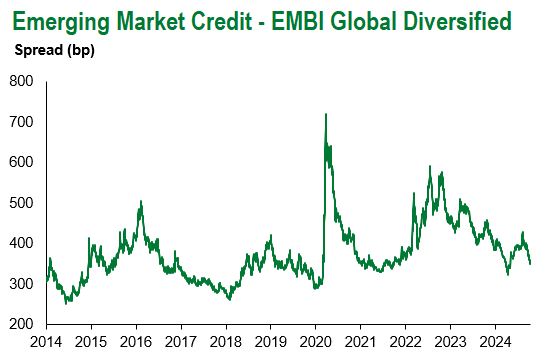
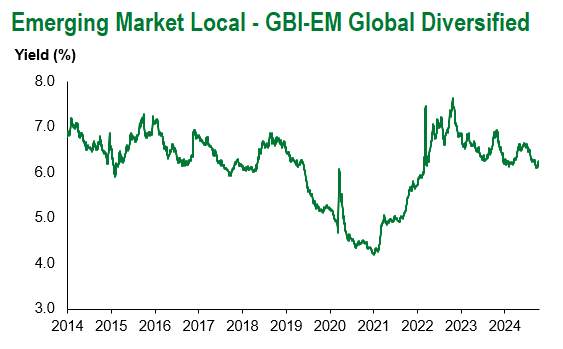
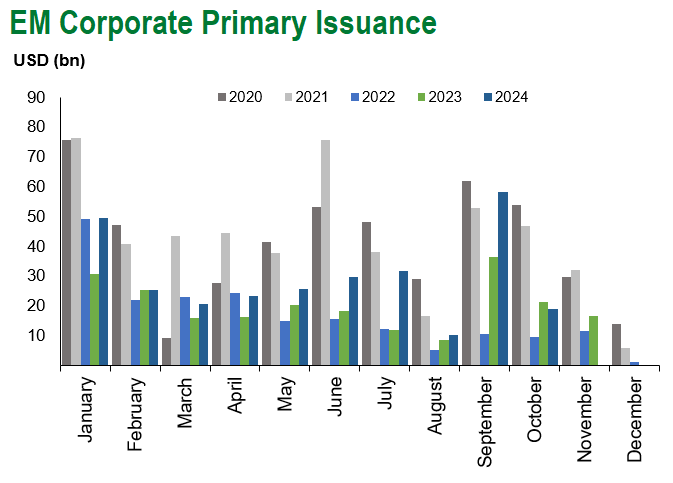

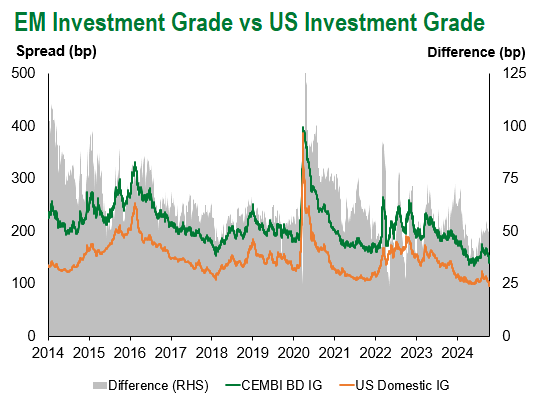
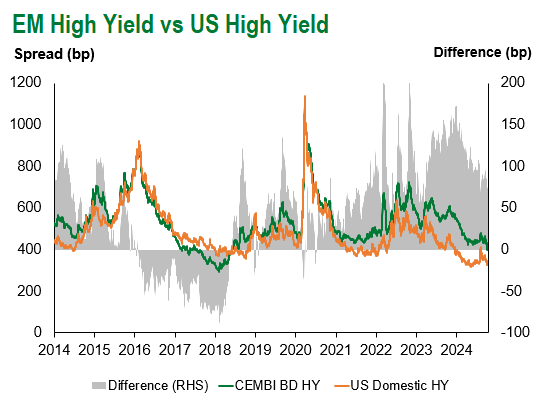
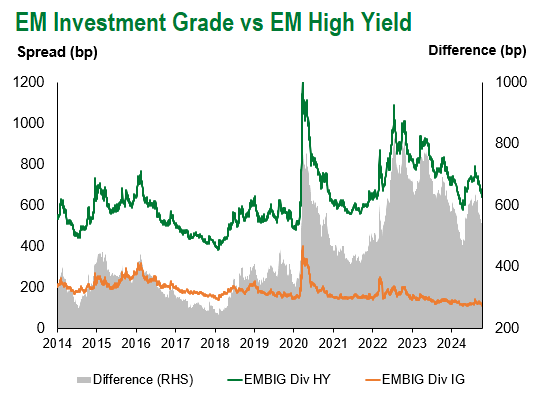
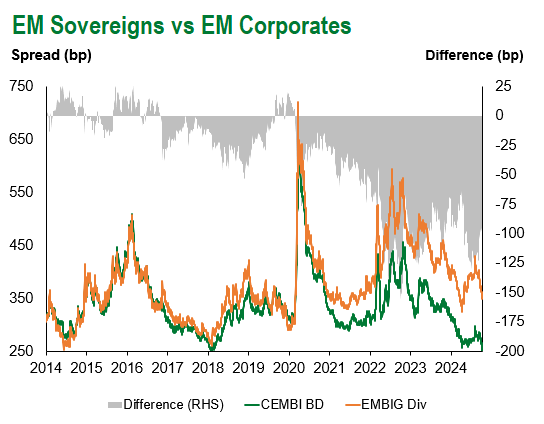
Emerging Markets Flows
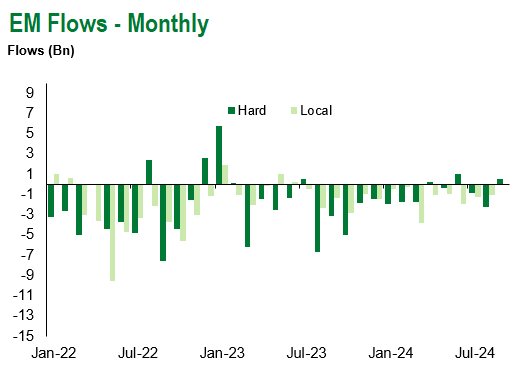
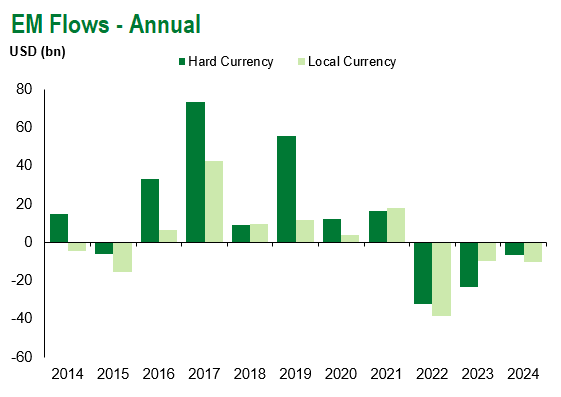
Source for graphs: Bloomberg, JPMorgan, Gramercy. As of October 11, 2024.
For questions, please contact:
Kathryn Exum, CFA ESG, Director, Co-Head of Sovereign Research, [email protected]
Petar Atanasov, Director, Co-Head of Sovereign Research, [email protected]
James Barry, Director, Deputy Portfolio Manager, [email protected]
This document is for informational purposes only. The information presented is not intended to be relied upon as a forecast, research or investment advice, and is not a recommendation, offer or solicitation to buy or sell any securities or to adopt any investment strategy. Gramercy may have current investment positions in the securities or sovereigns mentioned above. The information and opinions contained in this paper are as of the date of initial publication, derived from proprietary and nonproprietary sources deemed by Gramercy to be reliable, are not necessarily all-inclusive and are not guaranteed as to accuracy. This paper may contain “forward-looking” information that is not purely historical in nature. Such information may include, among other things, projections and forecasts. There is no guarantee that any forecasts made will come to pass. Reliance upon information in this paper is at the sole discretion of the reader. You should not rely on this presentation as the basis upon which to make an investment decision. Investment involves risk. There can be no assurance that investment objectives will be achieved. Investors must be prepared to bear the risk of a total loss of their investment. These risks are often heightened for investments in emerging/developing markets or smaller capital markets. International investing involves risks, including risks related to foreign currency, limited liquidity, less government regulation, and the possibility of substantial volatility due to adverse political, economic or other developments. References to any indices are for informational and general comparative purposes only. The performance data of various indices mentioned in this update are updated and released on a periodic basis before finalization. The performance data of various indices presented herein was current as of the date of the presentation. Please refer to data returns of the separate indices if you desire additional or updated information. Indices are unmanaged, and their performance results do not reflect the impact of fees, expenses, or taxes that may be incurred through an investment with Gramercy. Returns for indices assume dividend reinvestment. An investment cannot be made directly in an index. Accordingly, comparing results shown to those of such indices may be of limited use. The information provided herein is neither tax nor legal advice. Investors should speak to their tax professional for specific information regarding their tax situation.
